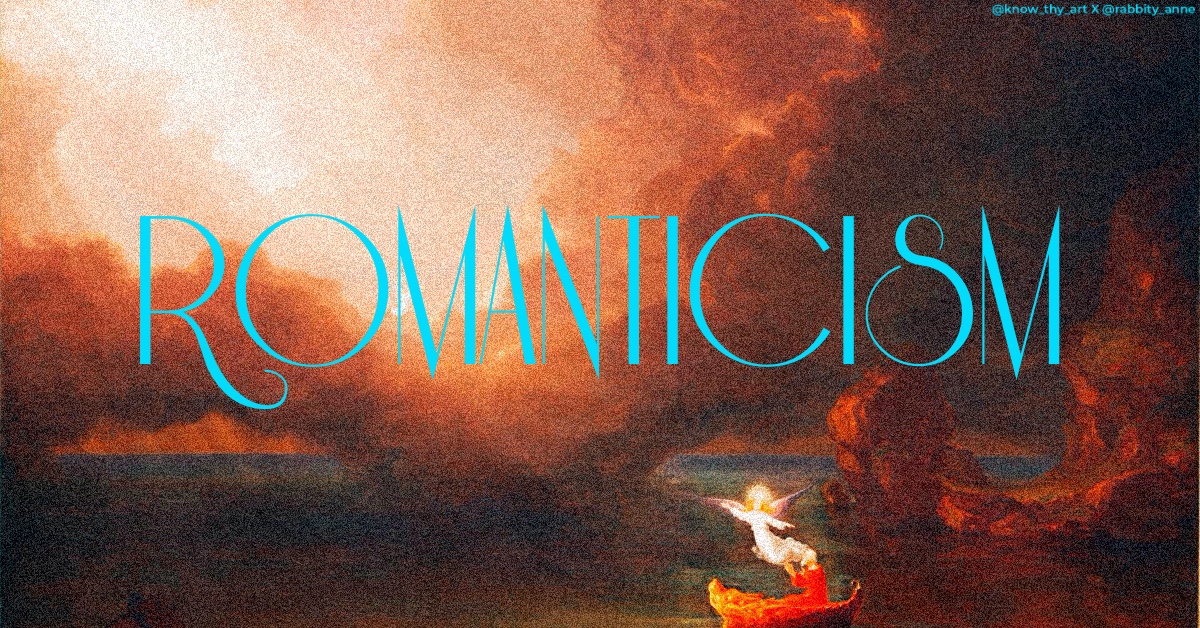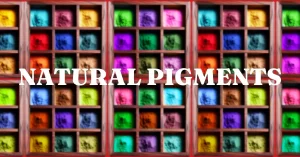We watch movies because we want to experience a fantasised version of reality. Unicorns, flying cars and superheroes offer us an escape to a romanticised world. The Romanticism Art Movement had a similar purpose. Paintings with dreamy skies, idyllic landscapes and gracefully choreographed human figures. Romanticism was meant to simply transport the viewer to a romanticised version of the world. This is why, more often than not, Romanticism paintings were based on scenes from a romantic poem or literature.
What type of art was created during the Romanticism art movement?
During the Romanticism art movement, paintings, poetry and literature were predominantly made.
Romanticism art was created and popular during which years?
Romanticism began around the late 1700s to 1850.
Where was Romanticism art made and popularised?
Romanticism began in Europe, particularly in France, with Jean-Jacques Rousseau. Later, a mixture of Romanticism and Neo-classical art emerged under the Academic art movement, which was also called Academism or Eclecticism.
What medium (media) and tools were used to make Romanticism Art?
Oil on canvas, watercolours and even gouache were used effectively to make Romanticism artworks.
Who are some famous Romanticism artists and artworks?
Liberty Leading the People by Eugène Delacroix
Wanderer above the Sea of Fog by Caspar David Friedrich
The Fighting Temeraire by J. M. W. Turner

Which art movement(s) came before the Romanticism movement?
Rococo art movement came before the Romanticism movement.
Which art movement(s) came after the Romanticism movement?
Realism art movement came after the Romanticism art movement.
Top 10 Artworks of the Romanticism Art Movement
The Romanticism art movement, which emerged in the late 18th and early 19th centuries, was marked by a fascination with nature, emotion, and the sublime. Romantic painters sought to convey the emotional and spiritual aspects of their subjects, often drawing from mythology, history, and literature. This article explores some captivating stories about famous paintings of the Romanticism era that have left an indelible mark on the world of art.
Wanderer above the Sea of Fog by Caspar David Friedrich

One of the most iconic paintings of the Romanticism movement is Caspar David Friedrich’s “Wanderer Above the Sea of Fog.” Painted in 1818, this masterpiece captures the essence of wanderlust and the human connection with nature. The painting depicts a solitary figure standing on a rocky precipice, gazing out over a sea of fog with mountain peaks emerging from below. Friedrich was a fervent admirer of nature, and this painting is believed to symbolise the Romantic longing for a spiritual connection with the natural world.
Caspar David Friedrich was known for his scrupulous attention to detail. To achieve the desired level of realism, he often visited the same locations multiple times, making numerous sketches and taking measurements. This particular painting was inspired by the rugged landscapes of the Bohemian and Saxon Switzerland regions, which Friedrich visited frequently.
Liberty Leading the People by Eugène Delacroix

“Eugène Delacroix’s “Liberty Leading the People” is a stirring depiction of the July Revolution of 1830 in France, which led to the overthrow of King Charles X. The painting portrays a symbolic figure of liberty leading a diverse group of rebels, including workers, students, and soldiers, over the barricades of revolution. Delacroix masterfully captures the tension and fervour of the moment.
Delacroix’s decision to paint “Liberty Leading the People” was a deeply personal one. He was a staunch supporter of the July Revolution, and he saw the painting as an opportunity to express his political and emotional involvement in the events. Delacroix’s enthusiasm for the revolutionary cause is expressed in the passion and energy of the characters in the painting.
The Raft of the Medusa by Théodore Géricault

Théodore Géricault’s “The Raft of the Medusa” is a monumental painting that portrays the tragic shipwreck of the French frigate Medusa in 1816. The ship ran aground off the coast of Mauritania, and the survivors endured unimaginable hardships, including cannibalism, while awaiting rescue. Géricault’s powerful and emotionally charged painting captures the desperation and suffering of the survivors.
Géricault’s commitment to accuracy in “The Raft of the Medusa” extended beyond the painting. To ensure the realism of the work, he visited morgues and hospitals to study the effects of decomposition on corpses. He even built a life-sized model of the raft and used real human body parts as references to accurately depict the bodies on the raft.
The Third of May 1808 by Francisco Goya

Francisco Goya’s “The Third of May 1808” is a haunting portrayal of the execution of Spanish citizens who rebelled against the Napoleonic occupation of Spain during the Peninsular War. The painting captures the stark contrast between the defiant figure in the foreground and the faceless, firing squad in the background. Goya’s work is a poignant and timeless condemnation of the brutality of war.
Goya’s personal connection to the events depicted in the painting adds depth to the artwork. As a witness to the atrocities of the Peninsular War, Goya’s firsthand experiences informed his passionate portrayal of the events. He refused to work for the French occupiers, and his works from this period are a testament to his dedication to bearing witness to the suffering of his fellow countrymen.
The Nightmare by Henry Fuseli

Henry Fuseli’s “The Nightmare” is a prime example of the Romantic fascination with the macabre and the supernatural. Painted in 1781, the artwork features a woman in a vulnerable state, seemingly possessed by a dark figure. The painting explores the darker recesses of the human psyche and has fascinated viewers for centuries.
Fuseli’s inspiration for “The Nightmare” is said to have come from his own sleep paralysis episodes, during which he experienced vivid and frightening hallucinations. His firsthand encounters with the terrors of the night became the basis for this evocative and unsettling artwork, making it a deeply personal and haunting creation.
The Hay Wain by John Constable

John Constable’s “The Hay Wain” is a quintessential representation of the Romantic fascination with nature and the countryside. Painted in 1821, the artwork depicts a tranquil scene by the River Stour in Suffolk, England. Constable’s dedication to capturing the beauty and simplicity of the English countryside is seen in the exquisite details of the landscape.
John Constable’s dedication to his craft was unwavering. He often spent hours in the countryside, making sketches and oil studies, to capture the ever-changing effects of light and weather. His commitment to realism and his love for the English countryside shines through in “The Hay Wain.”
The Slave Ship by J.M.W. Turner

J.M.W. Turner’s “The Slave Ship” is a searing indictment of the transatlantic slave trade. Painted in 1840, the artwork portrays a slave ship caught in a typhoon. The ship’s captain threw overboard sick and dying slaves to cash in on the insurance for lost cargo. Turner’s use of colour and light conveys the horror and turbulence of the scene.
Turner’s painting was inspired by the poem “The Slave Ship” by William Cowper, which recounted the horrifying events of the Zong slave ship massacre. The poem and the historical account of the event deeply affected Turner, leading him to create this powerful and emotive artwork.
The Oath of the Horatii by Jacques-Louis David

While Jacques-Louis David’s “The Oath of the Horatii” predates the Romanticism movement, it had a significant influence on later Romantic painters. The painting, completed in 1784, depicts a solemn oath-taking scene from ancient Rome. The artwork’s emphasis on patriotism, sacrifice, and heroism resonated with Romantic ideals.
Jacques-Louis David showed dedication to historical accuracy in “The Oath of the Horatii.” He thoroughly researched Roman architecture, clothing, and weaponry to ensure that every detail of the painting was true to the historical period.
Prometheus Bound by Peter Paul Rubens

“Prometheus Bound” by Peter Paul Rubens is a powerful portrayal of the Greek mythological figure Prometheus, who defied the gods to bring fire and knowledge to humanity. This painting captures the dramatic moment when Prometheus is bound to a rock as punishment for his defiance. The vivid depiction of suffering and resilience is a hallmark of the Romantic era.
Rubens’ fascination with the dramatic and emotional aspects of mythology shines through in “Prometheus Bound.” His ability to convey the agony and determination of the tortured hero adds depth and intensity to the artwork.
The Barque of Dante by Eugène Delacroix

Eugène Delacroix’s “The Barque of Dante” is a dramatic interpretation of Dante Alighieri’s “Inferno” from “The Divine Comedy.” The painting, completed in 1822, captures a scene from Dante’s epic poem in which Dante and Virgil witness the boatman Charon ferrying souls across the river Styx. Delacroix’s vivid depiction of suffering and torment aligns with the Romantic fascination with the emotional and the sublime.
Delacroix’s painting was heavily influenced by a visit to the Shakespeare Gallery in London, where he saw John Martin’s painting “Sadak in Search of the Waters of Oblivion.” The dramatic and emotional impact of Martin’s work inspired Delacroix’s exploration of intense and turbulent subject matter.
The Romanticism art movement was a period of artistic exploration and expression that produced some of the most captivating and emotionally charged works in the history of art. These famous paintings of the Romanticism era reveal the depth of passion, personal experiences, and commitment to ideals that fuelled the creativity of these remarkable artists. These paintings continue to inspire and resonate with viewers, reminding us of the enduring power of artistic expression to convey the complexities of the human experience.
*Images from Wiki Commons







0 Comments